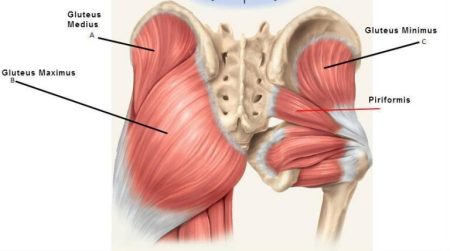Your End of Summer Glute Daily Yoga Guide
by Thalia Wynna, PT, DPT, AT, RYT-200
PEACH SEASON: YOUR END OF SUMMER GLUTE DAILY YOGA GUIDE
Ever wonder why world-class athletes have aesthetically pleasing donks? They aren’t for show, that’s for sure. World class athletes like Serena Williams put their glutes to work! And you should too. Read on to learn about this powerful muscle group and what you can do to protect the function of your peach.
Anatomy Class
Let’s start with an anatomy lesson. What are the glutes? The glutes are composed of three different muscles: gluteus maximus, gluteus medius, and gluteus minimus. They attach from the pelvis and sacrum to the femur. They each have special roles to play in helping us move efficiently.
Gluteus maximus is responsible for hip extension and external rotation (fig B). It also helps keep your trunk upright. Hence why the gluteus maximus is a posture muscle. It keeps you erect and works to propel you forward when you walk, climb stairs, stand up from a chair, etc.
Gluteus medius and minimus abduct and internally rotate the hip. It also keeps the pelvis level when you are standing on one leg (fig C). It is integral to help avoid hip drop and maintain your balance while walking, running, and hitting tree pose with grace and poise.

When your glute muscles are weak, a common issue in many – especially those that sit for most of the day and live sedentary lifestyles – it can lead to a cascade of problems. All the motions that these muscles are responsible for coordinating become imbalanced. The hip and knee joint movements are altered, and other muscles and body regions try to compensate for the lack of work done by the glutes – most commonly the quadriceps and back muscles. These muscles become overworked, movements become dysfunctional, and joint, muscle, or tendon breakdown begins to occur. Diagnoses are given such as patellofemoral pain syndrome, greater trochanteric bursitis, hip and knee osteoarthritis, lumbar radiculopathy, chronic low back pain, hip flexor tendinopathy, IT band syndrome, piriformis syndrome, gluteal tendinopathy, even recurrent ankle sprains. All these diagnoses and more can boil down to poor glute activation. In turn, having great glute activation and strength can aid you in your ability to avoid chronic injury, move more efficiently in your everyday life, and compete powerfully like Serena Williams ;). If you are a LYT subscriber, count yourself lucky because we activate your glutes at the beginning of every single class during The Reset. One way to strengthen your glutes is by participating in strength training 2-3x per week. According to a study in the Journal of Sports Science and Medicine, the following exercises are great gluteus maximus burners1 (classified as >60% of MVIC: max voluntary isometric contraction):
- Step-up
- lateral step-up,
- diagonal step-up
- crossover step-up
- hex bar deadlift
- rotational barbell hip thrust
- traditional barbell hip thrust
- American barbell hip thrust
- belt squat
- split squat
- in-line lunge
- traditional lunge
- pull barbell hip thrust
- modified single-leg squat
- conventional deadlift
- band hip thrust.
Always remember, your strength gains are only as good as your ability to move through the strength exercises with great form and appropriate muscle activation. This is why a yoga practice like LYT is a fantastic way to check in with your movement patterns and glute activation potential every week to ensure you are moving in the most optimal ways. Give some love to your glutes by committing to a consistent yoga practice and strength routine. Check out Lara’s workshop dedicated to glutes here. Then, give the gift of a juicy peach to someone you love by referring them to a 2-week free trial on LYT daily yoga. We would love to see you there.
Happy Peach Season!
XO,
Thalia Wynne, PT, DPT, AT, RYT-200
@thalialovee


Figure B: Gluteus maximus, hip extension
Figure C: Gluteus medius in tree pose
Resources:
- Neto WK, Soares EG, Vieira TL, et al. Gluteus Maximus Activation during Common Strength and Hypertrophy Exercises: A Systematic Review. J Sports Sci Med. 2020;19(1):195-203. Published 2020 Feb 24.
Picture sources:
Fig B: https://us.humankinetics.com/blogs/excerpt/learn-this-exercise-bridge-with-leg-kick











